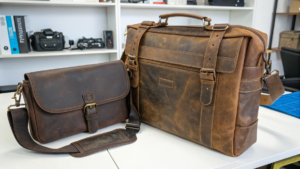What Materials Are in a Paper Bag?
When we ask, “What materials are in a paper bag?” the surface-level answer—paper, of course—barely scratches the surface. This simple question opens a deeper conversation about sustainability and industrial processes.
A typical paper bag is primarily made from kraft paper. This material comes from wood pulp. Understanding how pulp is sourced and processed shows the complexity of this common product.

The composition of a paper bag seems simple at first glance. We often just think of "paper." However, the truth is more complex. It involves choices about sustainability, industrial methods, and the trade-offs between "natural" and "eco-friendly" options. As someone in the corporate gifting industry, I always look closely at materials. Let me explain.
What is the Raw Material of Paper Bags?
Are you curious about what makes a paper bag strong enough to carry your groceries? It all starts with the basic raw material: wood.
Most paper bags get their strength from wood pulp. Specifically, they use cellulose fibers extracted from softwood trees like pine. This raw material is key to the bag's durability.

Paper bags largely use kraft paper. This paper is made through the chemical kraft process. This process takes cellulose fibers from wood. These fibers, mostly from softwood trees such as pine, are chosen for their long, strong strands. These strands give paper bags the strength to hold heavy items. This strength, however, has a cost. The pulping process uses chemicals like sodium hydroxide and sodium sulfide. If these chemicals are not managed well, they can harm the environment. Even though paper bags can biodegrade, their production uses a lot of resources. They often need large amounts of water and energy. Sometimes, they even use more resources than plastic bags.
What are the Components of a Paper Bag?
Do you ever wonder what else is in a paper bag besides just paper? The components go beyond simple pulp.
Beyond the main paper fibers, paper bags can contain various additives and coatings. These are used to improve features like moisture resistance or appearance. These extra components can make the bag more durable or visually appealing.

Not all paper bags are the same. Some bags have additives to make them resist moisture or look better. These additives can include wet-strength resins, laminated layers, or even plastic linings. When a bag has this mix of materials, it becomes harder to recycle. This also lessens the bag’s environmental benefits. In such cases, the idea of paper being "eco-friendly" becomes less clear. It reminds us that "paper bag" does not always mean pure or 100% recyclable. The more coatings or treatments added, the harder it becomes to dispose of them properly. Understanding these components is important for making smart choices about what we use. As a branding manager, I know that even a simple bag speaks volumes about a company's values.
Common Additives and Their Purpose
| Additive Type | Purpose | Impact on Recycling |
|---|---|---|
| Wet-Strength Resins | Increases strength when wet | Can hinder pulping process |
| Laminated Layers | Provides moisture barrier | Often makes bag unrecyclable |
| Plastic Linings | Creates waterproof barrier | Prevents paper recycling |
| Dyes and Pigments | Adds color for aesthetic appeal | Can complicate de-inking |
| Clay Coatings | Improves print quality and smoothness | Can add non-fiber content |
It is easy to think a paper bag is just paper. But in many cases, this is not true. These additives change the bag's core identity. They move it away from being a simple, easily recyclable item. When I work with clients on corporate gifts, we often discuss the material breakdown of bags we might use. It is important to know if a bag is truly eco-friendly or if it has hidden components. This helps us make responsible choices for branding and sustainability. My experience in production showed me these nuances.
The Trade-Offs of Enhanced Features
When manufacturers add these components, they aim to make the bag better for specific uses. For example, a bag for a cold drink needs to resist moisture. A bag for a luxury item needs to look good and feel strong. Each addition, however, adds complexity to the bag's end-of-life. A fully paper bag breaks down easily. A paper bag with a plastic lining does not. This is a big challenge for recycling plants. They have to separate materials that are hard to separate. This means many "paper" bags with additives end up in landfills. This is not the eco-friendly outcome we expect from paper. It is a constant reminder that we need to look beyond the surface. For Jacky, finding eco-friendly materials is a big challenge.
What are Most Paper Bags Made Of?
Are you curious about the eco-friendlier side of paper bags? Many bags today are made with a blend of materials.
Many paper bags use recycled content. This is a step towards sustainable production. However, these bags often mix recycled paper with new wood pulp1 to keep them strong enough for use.

On the more sustainable side, many paper bags include post-consumer recycled paper2. This is a big step toward making products in a circular way. Recycled fibers are shorter and weaker than new ones. This means they often need a mix of new pulp to keep their strength. This shows a clear trade-off. To make recycled paper bags work well, we often need to balance recycled content with new materials. Paper bags show our larger struggle with sustainability. No material is perfect, and every solution has a compromise. For example, when I source materials for corporate gifts, I often look for high recycled content. But I know that for a durable bag, some virgin pulp is usually needed. It is about finding the best balance.
Balancing Recycled Content and Strength
The goal is to use as much recycled content as possible. However, the nature of paper fibers creates a limit. Each time paper is recycled, the fibers get shorter and weaker. This means they cannot be recycled forever. After a few cycles, the fibers become too short to make strong paper. This is why new, or "virgin," pulp is often needed. It acts as a fresh supply of long, strong fibers. This mix helps maintain the quality and strength of the paper bag. Without it, recycled bags might tear too easily. This balance is a key part of sustainable manufacturing. We try to maximize recycled use while ensuring the product is functional. This is a practical challenge I faced when I was in the printing factory.
The Role of Certification in Sustainable Sourcing
When we look at paper bags, certifications like those from the Forest Stewardship Council (FSC)3 become important. These certifications tell us about where the wood pulp comes from. An FSC certification means the wood comes from responsibly managed forests. This helps reduce the negative environmental impact of logging. It also ensures that the process considers social and economic factors. For businesses like mine, choosing certified paper bags is a way to show commitment to sustainability. It helps us avoid products linked to deforestation or poor labor practices. This adds another layer of complexity to understanding what a paper bag is made of beyond just the fibers themselves. It is about the whole story behind the material. Jacky also looks for eco-friendly materials, making this an important point for him too.
Conclusion
A paper bag contains cellulose fibers and chemical binders, sometimes with additives. Symbolically, paper bags are made of choices between strength and sustainability, challenging us to understand their full lifecycle.
-
Understanding wood pulp is crucial for grasping the strength and sustainability of paper products. Explore this link to learn more about its role in paper manufacturing. ↩
-
Post-consumer recycled paper plays a vital role in sustainable production. Discover its benefits and impact on the environment by exploring this resource. ↩
-
The FSC certification is key to ensuring responsible sourcing of paper materials. Learn more about its significance in promoting sustainability in the paper industry. ↩





